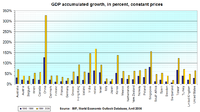
Photo from wikipedia
Previous studies have highlighted technological innovation as a key instrument for economic development. However, although the relationship between innovation and economic growth has been extensively explored, few studies have investigated… Click to show full abstract
Previous studies have highlighted technological innovation as a key instrument for economic development. However, although the relationship between innovation and economic growth has been extensively explored, few studies have investigated the impacts of crucial dimensions of innovation on economic growth. This paper presents one of the first empirical attempts to analyze how the “diversity” aspect of technological progress (or innovation) influences economic performance by considering the possible bidirectional causal effects between these two factors. A series of econometric techniques, including a two-stage-least-squares instrumental variable and dynamic autoregressive distributed lag model, are applied on a dataset of 55 countries. The dataset includes patent data from the United States Patent and Trademark Office and combined macroeconomic data from the World Bank’s development indicators and International Monetary Fund’s economic outlook databases. The results show that generally, technological diversity does not directly affect economic growth. By contrast, a negative effect of diversity on GDP per capita is observed in non-high-income countries. This study contributes to the macroeconomics and innovation management literature by providing an integrated empirical application of various popular firm management theories and a well-known endogenous economic growth theory.
Journal Title: Technological and Economic Development of Economy
Year Published: 2018
Link to full text (if available)
Share on Social Media: Sign Up to like & get
recommendations!